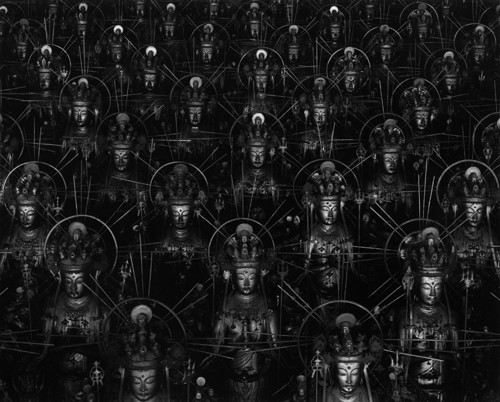Today we talk about a work by Hiroshi Sugimoto featured in the exhibition “Cosmos—Selections from the Hara Museum Collection” now on view at Hara Museum ARC.

Hiroshi Sugimoto,Hall of Thirty-Three Bays,1995(set of 48 prints)
The work in question is Hall of Thirty-Three Bays, consisting of 48 photographs that, arranged side by side, span the entire perimeter of Gallery A. This is a reprise of the work as it appeared in the artist’s solo exhibition held at Hara Museum ARC in 1996
They are photos of the one thousand statues that comprise the Thousand Armed Kannon at Sanjusangendo Temple in Kyoto, each one shot from a different spot, as if taking in the work while moving from one end towards the other. Devoid of manipulation and even color, Sugimoto’s photographs show us the statues through the mechanical (objective) gaze of the camera, thus stepping away from the inherently subjective view of the human eye, which is a product of human perception, cognition and experience. The result is an intellectually profound exploration of the statues’ essence. The Thousand Armed Kannon may be considered a quintessential example of faith manifested in physical form. By asking us to view this symbol of human spiritual activity through the objective lens of the camera, Sugimoto guides our attention to the nature of the cosmos that lies within each and every one of us.
The English word “photograph” comes from the Greek phos, meaning “light”, and graphê, meaning “drawing.” Devoid of color, Sugimoto’s photographs are studies of pure light and darkness. Indeed, in these photographs, the Thousand-arm Kannon seem to rise out from the light that fills the hall at Sanjusangendo Temple, making them truly “drawings made with light.”
—————————————————-
HARA MUSEUM ARC SPRING EXHIBITIONS
Kankai Pavilion (traditional East Asian art)
Selections from the Hara Rokuro Collection
Part I: March 26 (Sat.) – April 27 (Wed.)
Part II: April 29 (Fri./ National Holiday) – June 1 (Wed.)
Contemporary Art Galleries A, B and C
Cosmos: Selections from the Hara Museum Collection
Dates: March 26 (Sat.) – June 26 (Sun.)
* During the exhibition period, museum tours given by a curator will be offered every Sunday (in Japanese only, starting at 2:30 pm and lasting about 1 hour). The tour will include the open-view storage facility. Participation is on a reservation basis. Interested parties should call to reserve a place in advance (participants must be junior high school age or older). Tel: 0279-24-6585
Closed: Thursday )
* Subject to temporary closing in the event of severe weather.
Opening Hours
*Please click http://www.haramuseum.or.jp (website)
http://mobile.haramuseum.or.jp (mobile site)
———————————-
ACCESS
By Train
By JR Joetsu・Nagano Shinkansen
Recommended timetable
・10:12 Depart Tokyo Station→11:01 Arrive at Takasaki Station/ 11:11Depart Takasaki Satation→11:35 Arrive at Shibukawa Station
・11:12 Depart Tokyo Station→12:03 Arrive at Takasaki Station/ 12:20 Depart Takasaki Satation→12:44 Arrive at Shibukawa Station
・12:24 Depart Tokyo Station→13:14 Arrive at Takasaki Station/ 13:31 Depart Takasaki Satation→13:56 Arrive at Shibukawa Station
By JR Joetsu Limited Express Kusatsu
・ 9:00 Depart Ueno Station→10:37 Arrive at Shibukawa Station (No.31 ; operates only on Saturdays, Sundays and holidays)
・10:00 Depart Ueno Station→11:43 Arrive at Shibukawa Station (No.3 ; during April, operates only on Saturdays, Sundays and holidays)
・12:00 Depart Ueno Station→13:45 Arrive at Shibukawa Station (No. 5 ; during April, operates only on Saturdays, Sundays and holidays)
From Shibukawa Station, take the Kan-etsu Kotsu Bus and get off at the station “Green Bokujo Mae.” http://www.kan-etsu.net/r-bus/timetable/shibu-ikaho-1.htm (in Japanese only). ARC is about 7 minute walk from the bus station.
By Car
Take the Kan-etsu Expressway to Shibukawa Ikaho Interchange. Go in the direction of Ikaho Onsen for 8 km (about 15 min.) .
Highway information:
E-NEXCO Drive Plaza http://www.driveplaza.com/ (in Japanese only)
